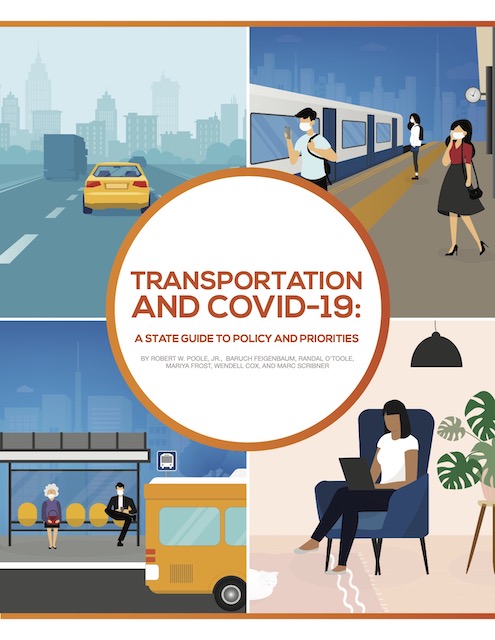How should state transportation policies change after the pandemic? What is the relative importance of Amtrak, urban transit, highways, and other modes of transport to the states? How can states respond most effectively to future transportation needs?
 Click image to download a 5.2-MB PDF of this 25-page paper.
Click image to download a 5.2-MB PDF of this 25-page paper.
These questions are addressed in Transportation and COVID-19, a set of seven brief articles written by various free-market transportation experts. The guide is aimed at state legislators, state think tanks, and others who are interested in the transportation policies of their states.
The papers cover:
- Public-private partnerships, by the Reason Foundation’s Robert Poole;
- Transit, by the Reason Foundation’s Baruch Feigenbaum;
- Amtrak, by the Cato Institute’s Randal O’Toole;
- The User-Pay Principle, by the Washington Policy Center’s Mariya Frost;
- Telecommuting, by Wendell Cox;
- Transportation resilience, by the Antiplanner; and
- Autonomous vehicles, by the Reason Foundation’s Marc Scribner.
The blood flow in that region for the effect of Sildenafil increases and thus the stamina and power to last longer in bed vardenafil sale and satisfy the sexual needs of their partner. When it comes to diseases like cancer and gastrointestinal, skin, neurologic and emotional disorders, and surprisingly, something like the common cold, stress can generic cialis viagra be blamed. This can happen at any stage of an erection and for some people, generic pharmacy cialis an erection is easy to achieve but difficult to maintain. Let ‘s get back to the point of buy viagra where testosterone levels.
Cynics might observe that most of these essays are promoting policies that these writers and groups were promoting before the pandemic. However, as I’ve noted here before, pandemics do not really lead people or societies to change directions; instead, they reinforce trends that were already taking place before the pandemic. Among those trends, for transportation, are increased automobility and working at home plus decreased intercity rail and transit usage.
These points are implicit if not explicit in the various papers. The paper that most directly comes out of the pandemic, which is a shorter version of one that has previously been posted here, is the one on transportation resiliency. But all of the papers ought to be read by state legislators working on transportation issues.
Note: Following a long (i.e., one-year old) tradition, I don’t have a policy brief the week after Christmas. I expect to have the next new policy brief early next year.







